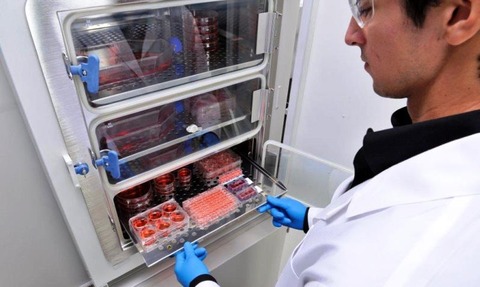Laboratory contamination: A three-part series
11 Jun 2014

Over the next three weeks Laboratorytalk, in partnership with Thermo Fisher Scientific, will introduce an exclusive, in-depth three-part series dedicated to the issues and themes surrounding laboratory contamination.
Part one, presented by Mary Kay Bates, global cell culture specialist and Douglas Wernerspach, business director, Thermo Fisher Scientific, is entitled: Types of contaminants.
When working with cell cultures, biological contamination is an ever-present problem in life science laboratories.
Contamination can waste time and money, and potentially invalidate published or current research.
Consequently, preventing contamination is a high priority when working with cell cultures in vaccine development and emerging regenerative medicine applications.
That said, it is a challenging task in today’s busy research labs. It is important to be able to identify what type of contaminant might be affecting your research in order to implement the appropriate preventive measures.
In this first part of the three-part series, we will help you better understand these types of biological contaminants and begin to look at ways of preventing such contamination.
Identifying the type of contaminant
There are several types of microorganisms that can contaminate mammalian cells, including bacteria, fungi, mycoplasmas and viruses.
Another type of biological contamination comes from related, aggressively growing mammalian cell lines that become mixed with the desired culture.
Bacteria and fungi - including moulds and yeasts - exist everywhere in nature and grow very quickly in cell culture media.
While the threat of contamination is ever-present, the detection of these microorganisms is typically straightforward.
Visual inspection of the culture flasks or Petri dishes can point to bacterial contamination if a turbid medium or yellowish colour (acid pH) is present.
Yeasts also cause growth medium to become turbid and cloudy, and mould is visually identified once its branched mycelia develop into furry floating clumps.
Bacteria sizes are typically measured in microns and can sometimes be observed under a 10x microscope within a few days after contamination.
Mycoplasmas are the smallest self-replicating organisms known and although they are technically bacteria; their structures do not include cell walls. The small size of mycoplasmas (0.2-0.8 µm) allows them to grow into dense numbers, but still escape visual detection.
These characteristics also mean it is not always possible to remove them using filtration through a 0.2 µm membrane.
Mycoplasmas are known to affect the metabolism, chromosomes, and morphology of the host cell.
These changes could have an effect on any data collected from infected cells. The best way to discover mycoplasma contamination is using a DNA stain followed by astute microscopic evaluation.
Viruses use host cell cultures for replication, and any drugs that might be used to eliminate them from a culture can be highly toxic to the cell line.
While viruses tend to be self-limiting in the cell cultures, the major concern is that laboratory personnel could become infected with the virus.
Safety precautions, a properly certified biological safety cabinet (BSC), use of proper aseptic technique, and health hazard warning labels are very important to protect laboratory workers from unknown, potentially infectious viruses present in human and primate cell lines.
Cross-contaminated human and animal cell lines are an increasingly recognised problem globally.
This type of contamination can undermine lab studies and there have been many documented cases of published research where cell lines identified as one type of cancer cell turned out to be another.
For example, HeLa cells derived from patient Henrietta Lacks’ cervical cancer in the 1950s are a very aggressive cell line, the first that was able to survive outside the human body.
The growth characteristics of this cell line, which played a key role in the launch of molecular oncology, also resulted in a serious problem of cross-contamination when HeLa cells accidentally contaminated other cell lines.
Unfortunately, the scientific community was slow to respond to this problem, resulting in many cases of flawed biomedical research.
Methods such as karyotyping and isozyme profiling can be used to detect interspecies cross-contamination while DNA analyses are required to identify intraspecies cross-contamination.
Preventing contamination
Aseptic technique is the single most important practice a lab researcher can use to minimise contamination by pathogens.
The technique has been used for decades by researchers that need to work in sterile areas with sterile reagents, media and glassware.
Working in a BSC and maintaining a sterile work area are critical. These procedures are critical in today’s busy laboratories and are the most economical way to reduce airborne microorganisms.
Good training, record keeping, planning and an organised, clean laboratory are the best approach for combating contamination.
Routine use of antibiotics in growth media should be avoided since overuse not only selects for resistant organisms, but also masks any low-level infection. In addition, antibiotics are not effective against mycoplasmas.
Laboratory personnel themselves are often a source of contamination. When lab employees sneeze, cough or even speak to each other, contaminants can travel through the air and fall into cultures or onto previously sterile surfaces.
Skin and clothing are also sources introducing microbes into the lab. As such, it is important to wear a clean lab coat over street clothes in the laboratory environment.
Even motion caused by scientists walking through the lab can create airflow that moves dust off of horizontal lab surfaces and potentially into cell cultures, making it important to keep all lab surfaces clean, not just work surfaces.
Managing contamination
If contamination does occur, lab personnel need to carefully manage the situation by firstly identifying the type of contamination and then identifying the cause of that contamination.
This will allow laboratory management to determine and establish the best long-term solution, to minimise or prevent future contamination.
An essential requirement for all cell culture labs working with cell lines is to implement a mycoplasma screening programme.
The second part of this three-part series will discuss more in-depth tips for preventing contamination.

